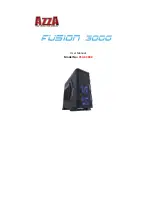
3
CAUTION: Never use rechargeable batteries to
power the Sensor. It is recommended batteries be
changed annually.
5. Install the Batteries into the Sensor, following the
polarity indicated in the battery cavity. A red LED
will come on briefly for approximately 1 second
to confirm that the batteries have been properly
installed. See Figure 5a
.
6. Press the Programming Button (See Figure 6)
on the back of the Remote Transmitter that was
supplied with the Awning until the Motor “jogs”.
A “jog” is a short back and forth movement of the
motor.
Note: The detection of windy conditions corresponds
to sensing the movement up and down of the
Front Bar and the Lateral Arms of the Awning. The
reaction of the Sensor to this movement depends
on the sensitivity threshold set on the Sensitivity
Potentiometer (or Adjuster). See Figure 7
.
The Sensitivity Potentiometer can be set from 1 to 9
using a small flat screwdriver.
A setting of 1 is equal to a high sensitivity which
means light winds will cause the Awning to close.
A setting of 9 is equal to a low sensitivity which means
stronger winds will cause the Awning to close.
Note: Do not set the Potentiometer to zero (0).
8. If not already accomplished, set the Sensitivity
Potentiometer dial to two (2).
9. Put the Sensor Unit back into the Housing. See
Figure 5
.
Figure 7
Potentiometer, or
Sensitivity Adjuster
10. Slide the Housing back onto the Mounting Plate
that you mounted on the Lateral Arm in Step 3c. If
you are using a ladder to install the Wireless Wind
Sensor, prior to testing the Sensor, move the ladder
away from the Awning.
Note: The Wind Sensor will not function unless it
is properly assembled to the Mounting Plate as
outlined in Step 10.
To check that the Wind Sensor communicates
properly with your Motor:
11. Shake the Awning Front Bar up and down (lift
the Front Bar approximately one foot, then drop it)
quickly 3 - 5 times in a row (for approximately 12
seconds) to simulate the effect of strong wind; this
should cause the Awning to automatically close.
2 AAA
Batteries
Figure 5a
Polarity Indicators
are located under
Batteries and at
end of unit.
+
_
7. Press the Programming Button located on the
Sensor (See Figure 6) until the Motor “jogs,” then
release. The red LED will come on briefly again.
Note: If the Motor does not respond with a jog or
movement, ensure the LED lights up when pressing
the Programming Button on the Wireless Wind
Sensor. If this does not occur, check placement of the
batteries. Refer back to Step 5 and Figure 5a.
Figure 6
Remot
e Transmitt
er
Wind Sensor
THEN, press the
Programming Button
inside the Wireless
Wind Sensor.
FIRST, press the
Programming Button
inside small opening
on back of Remote.


























